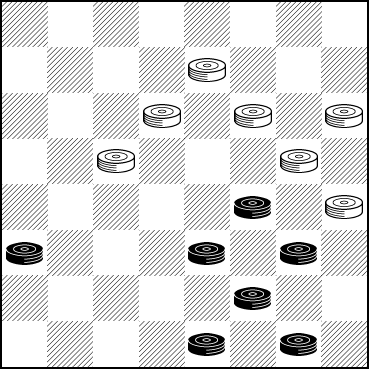The Checker Maven
Jump to navigationDouble Arrow

Onward and upward! Do these two arrows point the way to success? And will that success be on the checkerboard?
Today's Checker School entry, a position attributed to William Strickland, certainly looks like two arrows pointing upward -- from the Black side. (From the White side, the arrows point in a quite different direction.) Let's take a look.
WHITE

BLACK
Black to Play and Draw
B:W26,23,22,21,19,17,13:B14,12,10,9,6,2,1.
In the interest of fairness, we presume, the terms are Black to play and draw, and that would certainly be a success in such an awkward position. As for White, it's his game to win ... if he can.
Will your arrow hit the mark? Solve the problem and then shoot your mouse onto Read More to see the solution, explanatory notes, and seven--- yes, seven--- sample games.![]()
Solution
As always, lettered notes, sample games, and unattributed commentary are from Ben Boland's Famous Positions in the Game of Checkers. Numbered notes are by your Editor using the KingsRow computer engine with 10-piece endgame database.
10-15*, 19-10, 6-15, 17-10, 9-14---1, 13-9---A, 12-16*---2, 9-5, 16-20*, 22-17, 2-6---3, 26-22, 14-18*, 23-14, 6-9. Drawn---4.
Game: 9-14, 22-17, 11-15, 17-13, 8-11, 24-19, 15-24, 28-19, 11-16, 25-22, 7-11, 29-25, 3-7, 22-15, 11-15, 25-22, 15-24, 27-11, 7-16, 23-19, 16-23, 26-19, 5-9, 30-26, 4-8, 26-23, 8-11, 32-28, 11-15, 31-26, 15-24, 28-19. Forms above position.
Game: 10-14, 22-17, 7-10, 25-22, 11-15, 23-18, 14-23, 27-11, 8-15, 17-13, 3-7, 29-25, 15-19, 24-15, 10-19, 32-27, 9-14, 22-17, 7-10, 26-23, 19-26, 30-23, 5-9, 23-19, 4-8, 25-22, 8-11, 27-23, 11-15, 31-26, 15-24, 28-19. Forms above position.
Game: 9-13, 22-17, 13-22, 25-18, 10-14, 18-9, 5-14, 24-19, 11-16, 28-24, 16-20, 26-22, 8-11, 22-17, 11-16, 17-10, 7-14, 29-25, 4-8, 25-22, 8-11, 22-17, 2-7, 17-10, 7-14, 30-25, 3-7, 25-22, 6-10, 22-18, 1-5, 18-9, 5-14. Forms above position, colors reversed.
Game: 10-15, 21-17, 15-19, 23-16, 11-20, 26-23, 9-13, 24-19, 6-9, 22-18, 13-22, 18-15, 8-11, 25-18, 11-16, 28-24, 9-14, 18-9, 5-14, 29-25, 7-11, 15-8, 4-11, 25-22, 2-7, 30-25, 7-10, 25-21, 3-7, 22-18, 1—5, 18-9, 5-14. Forms above position, colors reversed.
Game: 11-15, 21-17, 8-11, 17-13, 9-14, 25-21, 11-16, 24-19, 15-24, 28-19, 4-8, 29-25, 8-11, 22-17, 11-15, 25-22, 15-24, 27-11, 7-16, 23-19, 16-23, 26-19, 5-9, 32-28, 3-8, 30-26, 8-11, 26-23, 11-15, 31-26, 15-24, 28-19. Forms above position.
Game: 11-16, 24-19, 8-11, 22-18, 16-20, 26-22, 11-16, 22-17, 9-14, 18-9, 5-14, 25-22, 4-8, 22-18, 8-11, 18-9, 6-22, 30-26, 10-14, 26-10, 7-14, 28-24, 1-5, 29-25, 3-7, 25-22, 2-6, 22-18, 6-10, 18-9, 5-14. Forms above position. colors reversed.
Game: 11-16, 24-19, 7-11, 22-17, 9-14, 25-22, 11-15, 29-25, 15-24, 28-19, 8-11, 17-13, 3-7, 22-17, 11-15, 25-22, 15-24, 27-11, 7-16, 23-19, 16-23, 26-19, 4-8, 30-26, 8-11, 26-23, 5-9, 32-28, 11-15, 31-26, 15-24, 28-19. Forms above position. Wm. Strickland, “Robertson's Guide," Part 3, Var. 9.
A---22-17, 2-6, 26-22, 12-16, 23-18 (10-7, 15-19. Drawn, Strickland), 14-23, 17-14, 15-19, 10-7, 6-10, 21-17, 10-15, 7-3, 19-24, 3-7, 15-19, etc. Drawn. Rubin vs. Garwood.
1---12-16 loses as Black can't allow the 13-6 exchange.
2---But now 12-16 is a star move!
3---Or 20-24.
4---22-18 15x22 10-6 1x10 14x7 to a straightforward draw.
In the "Post Guide," May 1903, then later in George A. Pierce’s "Single Corner" Book, Henry Spayth gave 36 games leading up to the above position with the following interesting facts:
“There are thirty-six games ending with the above position, seventeen of which are colors reversed.
It will be noticed that the position is formed by 11-15 with all possible replies, colors reversed, excepting 11—15, 24-19.
Also by 10-15 with all possible replies, colors reversed, excepting 10-15, 24~19.
Also with all possible first moves with Blacks colors reversed excepting 11-15 and 10-15.
It is a curious feature, that while the 19 games forming the above position, each contain. 32 moves; 17 with colors reversed, 10 have 33 and 7 only 31 moves.
Mr. Chas. Hefter said in Turf Field and Farm: 'We will have to credit William Strickland, the blind—fold player, with this excellent problem, the formation of which from Second Double Corner and both sides of the Bristol, makes one of the greatest curiosities of Checker literature.'
Mr. Hefter and many others may be surprised to find the position evolved here in 33 other games."
You can email the Webmaster with comments on this article.
